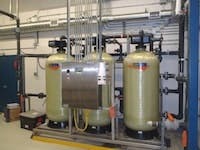Located in Canada’s Yukon, the Old Crow village is the only settlement located in the Northern Yukon Territory of Canada. The Old Crow community has a population of approximately 300 people and is only accessible by aircraft, barge or ice road every few years.
Challenge
High levels of manganese were found in the water that supplies this village. Due to these high levels, Yukon Eng. Services was selected to provide permitting and engineering consulting services for this project. Selected through a competitive bidding process, Wildstone Construction was selected to perform all the construction activities and AdEdge Water Technologies was written into the project to provide the water treatment equipment.
The existing system consisted of two wells; however, only one is active. The flow rate for the active well is 110 gal per minute (gpm). The water analysis indicated that the concentration of manganese, at 0.156 mg/L, exceeded the permitted levels allowed by the Guidelines for the Canadian Drinking Water Quality for Health Canada. The water analysis also indicated levels of arsenic and iron slightly below the drinking water standards at 8 ppb and 0.23 mg/L respectively.
Treatment System
The AdEdge treatment system featured an APU26 skid-mounted package unit, sized for a maximum design flow rate of 110 gpm. The model APU26-3072CO-3-315 utilizes AdEdge AD26 oxidation/filtration media in a three 30-in. diameter composite vessel configuration in parallel. Each vessel contains 13 cu ft of AD26 media for the removal of arsenic, iron and manganese.
The AD26 media is a highly catalytic manganese dioxide media for oxidation and filtration of arsenic, iron, manganese and hydrogen sulfide. Backwashing of the treatment system occurs once or twice a week depending on the incoming concentrations of iron and manganese to remove any oxidized iron that precipitated in the bed.
The AdEdge treatment system used an InGenius programmable logic controller (PLC) to perform the automated functions needed for the proper operation of the filtration system and to control other external ancillary equipment. The treatment system uses a 3150 Fleck valve on each vessel that is controlled by the InGenius PLC. System features also include flow sensors and totalizers, local pressure gauges, pressure sensors and a hydraulic panel to serve as a common location for the reading of system inlet and outlet pressure.
Prior to entering the treatment system, the raw water is treated with sodium hypochlorite via an AdEdge ADIN chemical feed system to oxidize the arsenic, iron and manganese for optimal removal with the AdEdge AD26 media. In order to keep a chlorine residual for disinfection, a second ADIN chemical feed system using sodium hypochlorite is installed downstream of the filtration system. A third ADIN chemical feed system is a rechlorination sodium hypochlorite pump used to keep an active amount of chlorine in the system at all times.
Performance Results
The system was started up and commissioned in February 2013. Since the project began operation, the manganese level dropped from 0.156 mg/L to non-detectable levels. Arsenic and iron levels are also at non-detectable levels.
Maxime Montoya can be reached at [email protected] or 678.835.0052.


